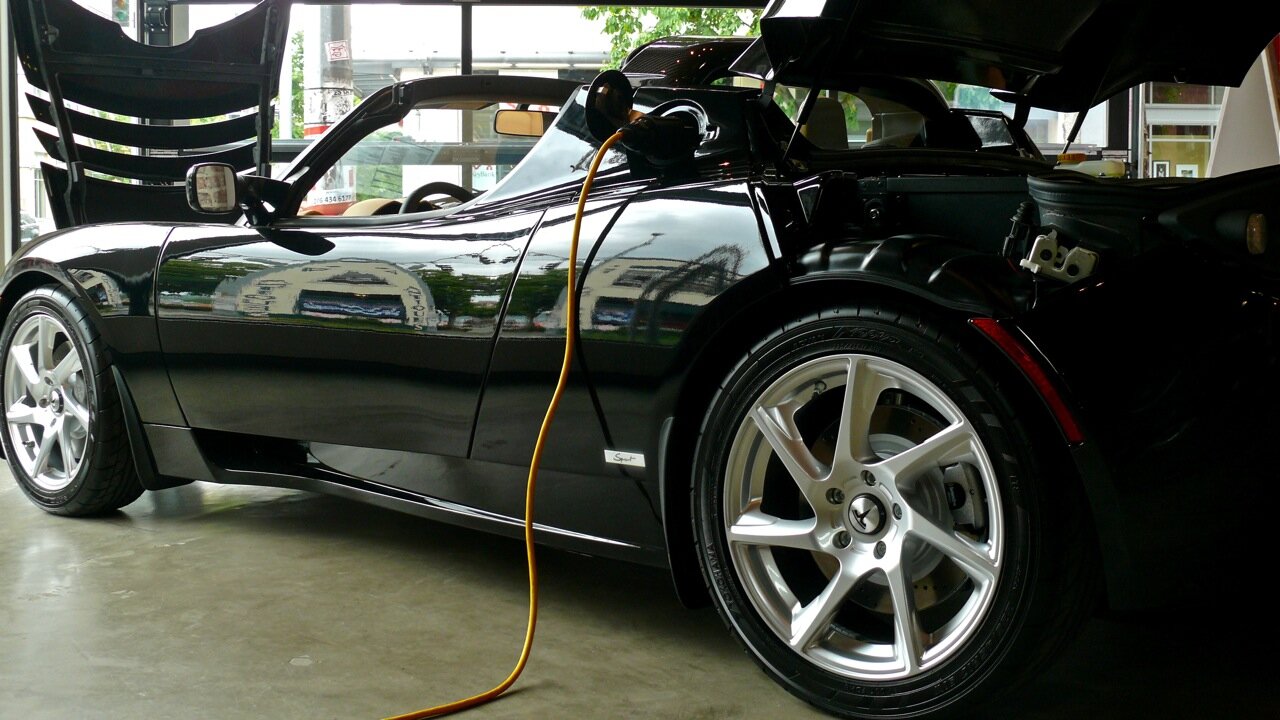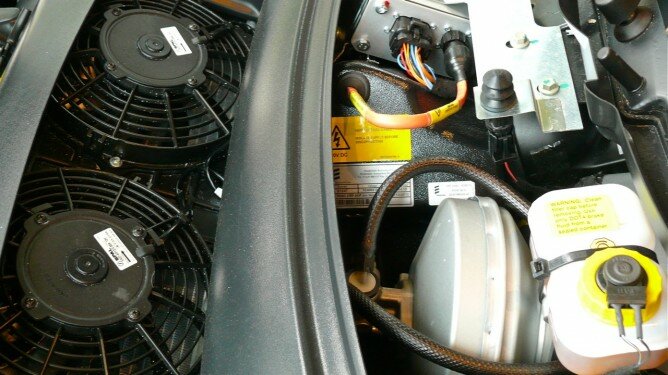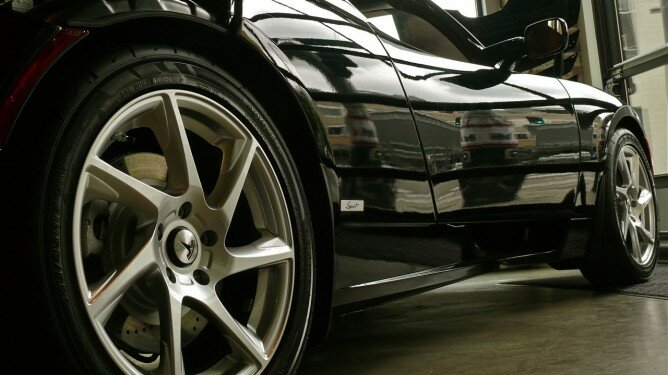Down at 435 Westlake Avenue North, there’s an old brick building with big windows that frame a gleaming black Tesla Roadster. Seattle’s Tesla showroom is not particularly conspicuous, but then people with $109,000 to spend on a high-performance electric car probably don’t just pop in off the street.
Up close, the Tesla Roadster resembles nothing so much as your childhood electric race car come to Lotus-inspired life. Low-slung, it accelerates from 0-60 in 4 seconds, says Car & Driver, thanks to a single-speed gear reduction transmission, carbon fiber, and a motor that (in the even pricier Sport model) achieves 288 horsepower.
In EPA theory, you can also drive 248 miles on a single charge, though as with any car, mileage may vary, even if you’re the co-founder. Then, C&D says, “Using Tesla’s special $3000 70-amp, high-capacity charger, the car will tank up in fewer than four hours. On our $19 Home Depot do-it-yourself kludged-up 240-volt, 40-amp garage charging circuit, the Tesla needed eight hours for a full zero-to-hero charge-up.”
If you’re asking yourself who drops $110,00 (Roadster, base) to $155,000 (Sport, loaded) on an electric car, Genny Carter, Tesla’s Seattle store coordinator, says car collectors, technologists (from Microsoft), and sports car aficionados are among that group. But also, she says, “we’ve had environmentalists, people who have never paid more than $40,000 for a car in their lives, walk in to order one.”
That last demographic may be more interested in the Tesla Model S, a sedan that’s supposed to arrive on showroom floors in 2012. After a tax rebate, the Model S should sell for around $50,000. It’s still very fast–reaching 60 mph in under six seconds, and topping out at 120–and it will come with three battery packs that allow different driving ranges (160, 230, or 300 miles), and recharge in as little as 45 minutes.
UPDATE: Tesla says it’ll be ceasing production of the Roadster to focus on the Model S.
Still, since Tesla has sold some 1,650 Roadsters through March 2011, you could fairly say that the company has been far more successful in creating publicity than cars. In the Revenge of the Electric Car documentary, a thrilling inside-the-conference-room follow-up to the more pissed-off Who Killed the Electric Car?, Tesla and its charismatic founder Elon Musk get equal time with GM and Nissan, but the investment and market-share of the latter two are worlds away.
GM’s Volt sold 1,200 units in the first quarter of 2011. Nissan Leaf sales are expected to reach 10,000 in the U.S. alone, by the end of 2011. That’s with price tags of $40,000 and $33,000, respectively, after tax rebates. And this just in: “Ford Motor Co. plans to add 220 jobs at plants in Michigan as it triples production of electric vehicles to 100,000 annually by 2013.”
Seattle residents driving electric cars can “fill up” away from home at a growing number of recharge stations: Vulcan just opened 24 at eight locations in South Lake Union this June. (The DOE map of recharging stations needs a big update.)
In Seattle, recharging is mostly guilt-free, ecologically speaking, since so much of our electricity comes from hydropower. Over at Sightline, Clark Williams-Derry recently compared the Leaf with hybrids, to see how the fuel economy and carbon emissions fared:
Personally, I think that the “right” way to think about the Leaf in the Northwest is the bar in the green: the marginal carbon emissions. And on that measure, the Leaf is a lower-carbon vehicle than the Prius. In fact—and purely coincidentally—the Leaf’s emissions work out to be just about the same as its EPA rating: the equivalent of a gas-powered car that gets about 99 miles per gallon.
But, elsewhere, a major caveat: “coal-fired power negates all of the climate benefits of electric cars.” You might as well drive a good mileage gas-powered car, concludes Williams-Derry, if you’re getting your electricity from coal.
That’s in reference to the current state of things, I imagine. It is possible to capture more CO2 from burning coal than we do. A point that both Revenge of the Electric Car and the Seattle Electric Vehicles Association‘s Steven Lough make is that, all things being equal, rather than have 250 million passenger-vehicle CO2-emission points, it’s a lot easier to corral the CO2 at the substantially fewer generation points. It’s probably safe to say that for many electric vehicle owners, this car will be the first that pollutes less the longer they drive it.
Lough advocates not waiting for the major car manufacturers to lure you into the electric vehicle you’ve been waiting for: The cost to convert your existing gas-powered car to pure electric (replacing motors) is less than $13,000, while your annual electricity costs could be something less than $280. (A back of the envelope calculation for $3.50/gal. gas is $1,400 per year.) If you’re a real environmentalist, he points out, you can’t overlook the benefits of recycling your existing car, can you?
There’s another benefit to electric car purchase, too: The money you spend on electricity in Seattle tends to stay in Seattle, which is not what happens when you fill up with gas. Around here, the more people switch to electric cars, the more money they save, and the more money Seattle City Light gets to fund its investment in alternate energy sources. Add solar power to your home’s roof, and the virtuous circle improves in strength.









